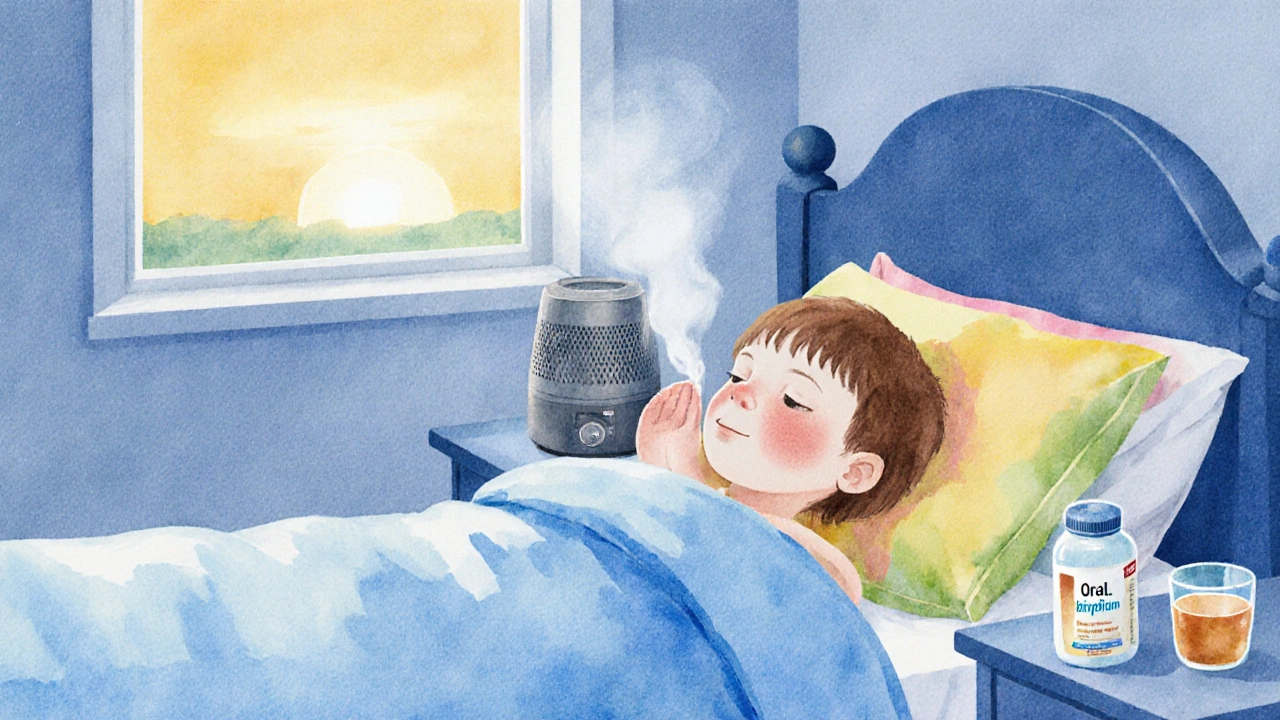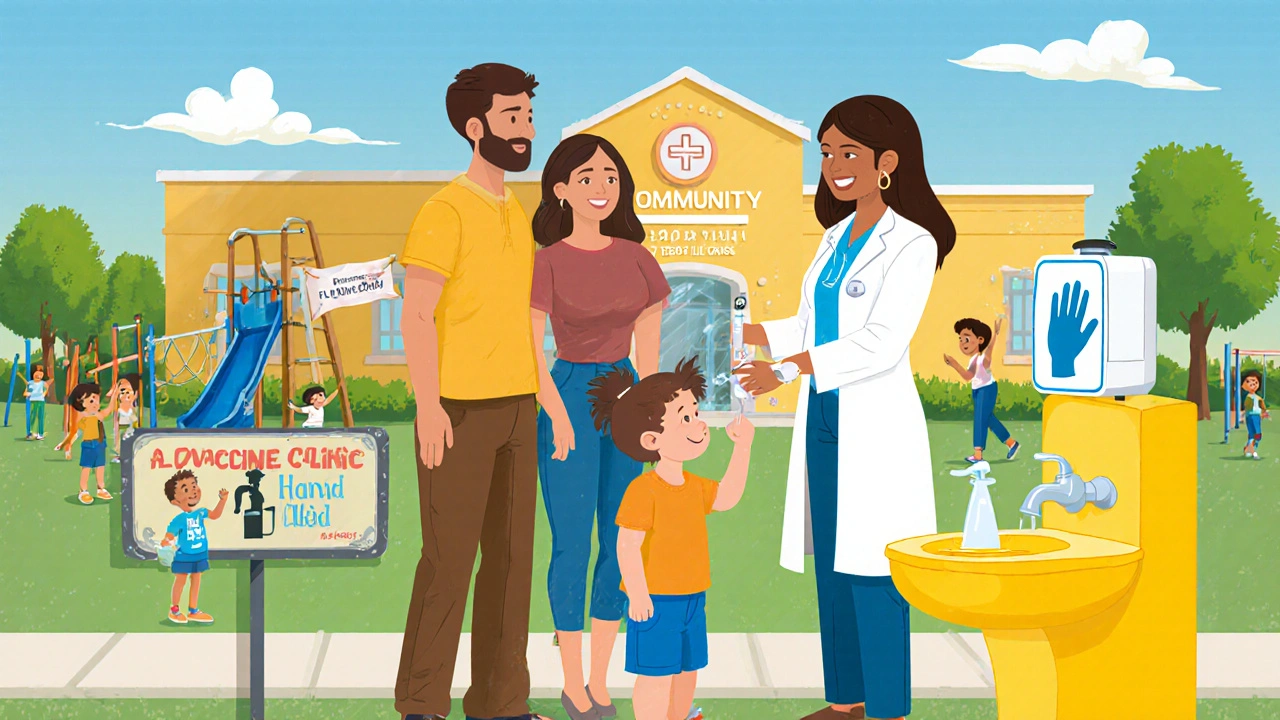Flu in Children: Key Symptoms, Effective Treatment, and Proven Prevention Tips

Child Flu Symptom Checker
Symptom Assessment
Flu Risk Factors
When influenza in children hits the household, parents often scramble to figure out what’s normal and what’s a warning sign. This guide breaks down the tell‑tale signs, the safest ways to treat it, and the best habits to keep the bug at bay.
Quick Takeaways
- High fever, sudden chills, and a dry cough are the most common flu in children symptoms.
- Contact a pediatrician if the child shows difficulty breathing, persistent vomiting, or a fever lasting more than 48hours.
- Antiviral medication works best when started within 48hours of symptom onset.
- Yearly flu vaccination and proper hand hygiene cut the risk by up to 60%.
- Hydration, rest, and a balanced diet are the backbone of home care.
What Exactly Is Flu in Kids?
Influenza is a contagious respiratory virus that comes in three main types-A, B, and C. Types A and B cause the seasonal flu spikes we see each winter. Children are especially vulnerable because their immune systems are still developing and they often share close spaces at schools or daycare. The virus spreads through droplets when an infected person coughs or sneezes, and it can linger on surfaces for up to 24hours.
Spotting the Symptoms Early
Kids don’t always describe how they feel, so look for these clues:
- Fever: A temperature above 100.4°F (38°C) that comes on suddenly.
- Chills and sweats: Rapid temperature swings are a hallmark of flu.
- Cough: Usually dry at first, becoming more productive after a few days.
- Sore throat: Often accompanies the cough.
- Runny or stuffy nose: May be mistaken for a cold, but flu tends to hit harder.
- Body aches: Kids may complain of “sore muscles” or move less.
- Fatigue: Sudden loss of energy, reluctance to play.
- Gastrointestinal upset: Nausea, vomiting, or diarrhea, especially in younger children.
These symptoms usually appear 1‑4days after exposure and peak within 2‑3days.

When to Call the Pediatrician
Most flu cases resolve at home, but certain signs require professional care. Call your pediatrician as soon as you notice any of these red‑flag symptoms:
- Difficulty breathing or rapid breathing.
- Chest pain or persistent wheezing.
- Dehydration signs-dry mouth, no tears, fewer wet diapers.
- High fever that doesn’t break with fever‑reducers after 48hours.
- Severe vomiting that prevents fluids intake.
- Neurological changes-confusion, seizures, or unusually drowsy.
Children with chronic conditions (asthma, diabetes, heart disease) should have a low threshold for seeking help.
Treatment Options: From Home Care to Antivirals
Most kids recover with supportive care. Here’s what works best:
- Rest: Let the body focus on fighting the virus.
- Fluids: Offer water, clear broth, or oral rehydration solutions. Aim for at least 1L per day for a 5‑year‑old.
- Fever reducers: Acetaminophen or ibuprofen (never give aspirin to children).
- Humidifier: Moist air eases cough and nasal congestion.
- Nasal saline drops: Safe for infants to clear blocked nostrils.
If the child is at high risk or symptoms are severe, doctors may prescribe antiviral medication such as oseltamivir (Tamiflu) or zanamivir, which shorten illness duration by about one day when started within 48hours. The usual course is five days, with dosage based on weight.
Over‑the‑counter cough syrups are generally not recommended for children under six because they offer little benefit and can cause side effects.
Prevention: Vaccination and Everyday Habits
The single most effective defense is the annual flu shot. The flu vaccine contains inactivated virus strains matched to the season’s most common circulating types. It reduces the risk of infection by 40‑60% and is safe for kids six months and older. For children under six months, vaccination of household members creates a protective “cocoon.”
Combine vaccination with these habits:
- Hand hygiene: Wash hands with soap for at least 20seconds, especially after coughing, sneezing, or returning from public places.
- Cover coughs: Use tissues or the elbow crease; discard tissues immediately.
- Disinfect surfaces: Wipe down toys, doorknobs, and tabletops with an EPA‑approved disinfectant.
- Avoid close contact: Keep sick children at home until fever‑free for 24hours without medication.
- Healthy lifestyle: Balanced diet, regular sleep, and physical activity strengthen the immune system.

Quick Flu‑Ready Checklist
- ✔️ Keep a thermometer and fever‑reducers within reach.
- ✔️ Stock oral rehydration solutions and clear broths.
- ✔️ Have a humidifier and saline drops ready.
- ✔️ Schedule the annual flu shot for the whole family.
- ✔️ Teach kids proper hand‑washing and cough etiquette.
| Treatment | How It Works | When to Use | Typical Side Effects |
|---|---|---|---|
| Rest & Fluids | Supports immune response and prevents dehydration | All mild‑to‑moderate cases | None |
| Acetaminophen / Ibuprofen | Reduces fever and eases aches | Fever > 100.4°F, pain | Stomach upset (ibuprofen), rare rash |
| Antiviral (Oseltamivir) | Inhibits viral replication | High‑risk or severe symptoms, started < 48h | Vomiting, mild nausea |
| Humidifier / Saline Drops | Moistens airways, clears mucus | Congestion, dry cough | None |
Frequently Asked Questions
How long does the flu usually last in children?
Most kids feel better in 5‑7days, but fatigue and a lingering cough can last up to two weeks.
Can a child get the flu from a vaccinated sibling?
Vaccination reduces the amount of virus a person sheds, so a vaccinated sibling is far less likely to transmit flu, though not 100% impossible.
Is it safe to give my child over‑the‑counter cough medicine?
For children under six, most cough syrups aren’t recommended because benefits are minimal and side effects can be serious. Use honey (for kids >1yr) or a humidifier instead.
When should I start antiviral medication?
Ideally within 48hours of symptom onset, especially for children with asthma, weakened immune systems, or who are under two years old.
How can I protect my newborn from the flu?
Vaccinate everyone in the household, practice strict hand hygiene, and limit visitors during flu season. Keep the newborn away from anyone showing flu‑like symptoms.
Next Steps for Parents
If you suspect flu, start logging temperature and symptoms now. Call your pediatrician if any red‑flag signs appear, and ask about antiviral eligibility. Schedule the next flu shot before the season spikes-usually in early October.
Remember, a combination of early detection, proper care, and prevention habits keeps your child healthy and reduces the chance of missed school days.


From a pathophysiological standpoint, influenza in pediatric cohorts precipitates a cascade of cytokine-mediated inflammation that can be quantified by elevations in interleukin‑6 and tumor necrosis factor‑alpha, thereby exacerbating systemic febrile responses.
When the nasopharyngeal epithelium is breached, viral ribonucleoprotein complexes hijack host transcriptional machinery, resulting in rapid viral replication cycles that outpace innate immune containment.
This mechanistic insight underscores why high-grade fevers above 103°F merit immediate antipyretic intervention coupled with vigilant fluid monitoring.
Empirical data from the CDC indicate that antiviral agents such as oseltamivir achieve a statistically significant reduction in viral shedding when administered within the first 48 hours of symptom onset.
Consequently, the therapeutic window is physiologically constrained, demanding prompt diagnostic triage in primary care settings.
Moreover, pediatric patients with comorbid asthma or immunodeficiency present a distinct risk stratification profile, wherein the severity index escalates dramatically with each additional comorbidity.
In such high‑risk cases, clinicians should consider a prophylactic dosage regimen adjusted for weight-based pharmacokinetics to mitigate progression to lower respiratory tract involvement.
From a public health perspective, herd immunity thresholds are contingent upon annual vaccine uptake rates surpassing 60% in the pediatric demographic, a metric that directly correlates with decreased community transmission.
Honestly, it’s amazing how a simple routine of hand‑washing and a good night’s sleep can keep the flu at bay for most kids.
Even though the guide is packed with details, the core take‑away is staying hydrated and watching for any red‑flag signs.
I totally get how scary it can feel when your little one is burning up and coughing nonstop.
Just keep offering small sips of water or oral rehydration solution, and use a cool‑mist humidifier to help ease the congestion.
Whoa, here we go with the drama again – another “must‑see‑doctor” alarm.
Kids get a cold, they get a flu, and suddenly the world ends?
Let’s be real, most of these symptoms resolve with rest and fluids, no need to panic‑shop antivirals unless the doc says otherwise.
Indeed, the guidance to monitor for difficulty breathing, persistent vomiting, or dehydration is vital.
Parents are encouraged to keep a thermometer handy and to document temperature trends to aid clinicians in decision‑making.
The recommendation to use acetaminophen or ibuprofen for fever is sound, yet it would be prudent to remind caregivers of appropriate dosing intervals based on weight.
Keep saline drops handy.
Observing that flu vaccines reduce infection risk by up to 60% highlights how community immunization acts as a protective barrier, especially for infants who cannot yet be vaccinated.